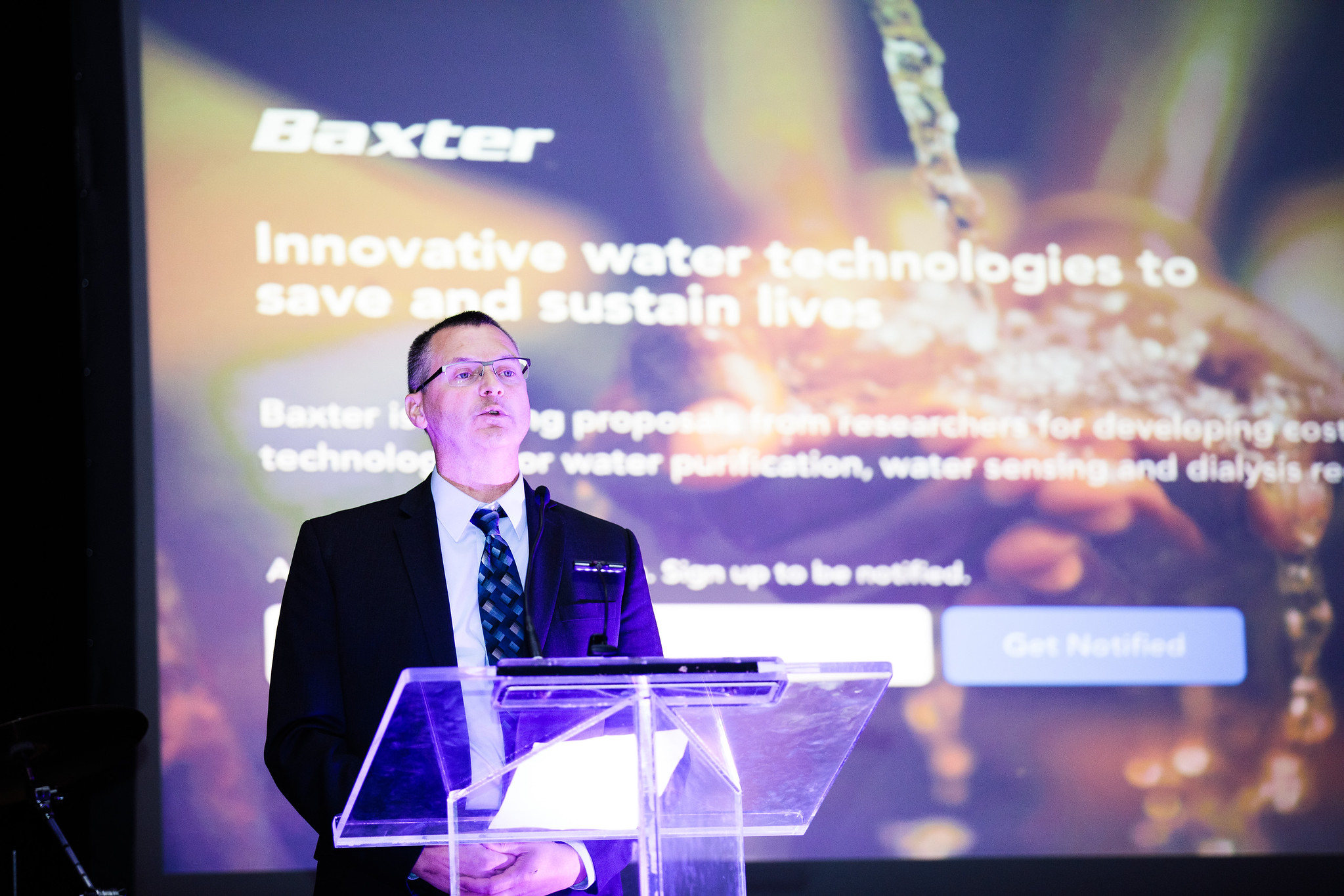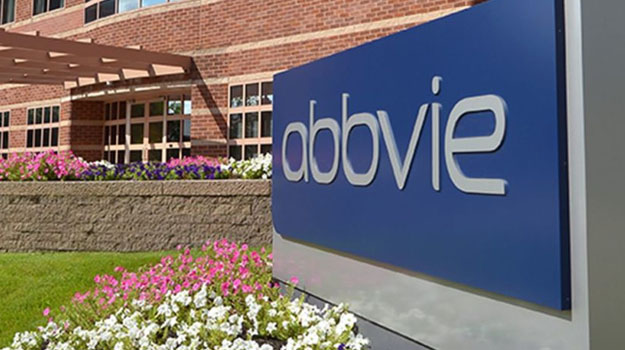Baxter (NYSE: BAX) is a Fortune 500 medical device company that develops products to treat kidney disease, hemophilia and other chronic conditions. One of its most successful products is a home dialysis machine, which uses a solution made from “ultra pure water” formulated in factories, packaged in IV bags and shipped in boxes to patients around the world. The average home dialysis patient receives 900 pounds (not a typo) of this solution every month.
To save patients from this burden, Baxter started asking the question: “What if we could make dialysis solution from tap water?”
Baxter posted three RFPs on Halo seeking technologies to address the challenge and received over 80 proposals from scientists across seven countries. Baxter has narrowed its search to these researchers below representing a variety of specialties and career stages. Meet them, learn more about their research and see what caught the attention of Baxter’s scientists.

Understanding the heterogeneous composition of chemicals and natural organic matter in water
Dr. Paul Westerhoff is a Regents Professor in the School of Sustainable Engineering and Deputy Director of NEWT at Arizona State University. In 2019 he was awarded the Clarke Prize by the National Water Research Institute for outstanding achievement in water science and technology . View Halo Profile >>
Tell us about your research
Our lab investigates chemicals and nanomaterials in environments, what risks they pose to human or ecosystem health, and how we can mitigate those risks with water treatment technologies. For risks associated with drinking water, we employ both new and existing technologies that are suitable for municipal scale, point-of-use and point-of-entry treatment processes. A key focus of ours is understanding the heterogeneous composition of chemicals, natural organic matter and chemicals in water.
A key focus of ours is understanding the heterogeneous composition of chemicals, natural organic matter and chemicals in water.
At the $40M National Science Foundation Nanosystems Engineering Research Center (NEWT), where I serve as Deputy Director, we are pioneering research into drinking and industrial water treatment technologies that leverage the broad electromagnetic spectrum and novel nanoscale mechanisms to design macro-scale water treatment devices.
What are some of the real-world applications of your work?
Our fundamental research in natural organic matter (NOM) characterization and reactivity is widely-used to understand advanced oxidation and formation of disinfection by-products in drinking water. Our techniques to quantify spectral properties of NOM are also widely-used to understand sources and transformations of NOM in the environment.
Our research into the characterization of engineered nanomaterials in food, water and consumer products has helped inform realistic exposure assessments for people and ecosystems.
We have developed large data systems and GIS-based models that reveal spatial and temporal patterns in wastewater impacts on rivers and drinking water sources. This is used to predict compounds of emerging concern (CEC) that should be a priori simulated. Our early research on efficiency of CEC removal by drinking water processes has been applied to reduce risks of planned and unplanned wastewater reuse.

Merging electrochemical phenomena with membrane separations
Dr. David Jassby is Associate Professor of Civil and Environmental Engineering at UCLA. He is the recipient of a $2M grant from the U.S. Department of Energy to improve energy efficiency in membrane distillation (MD) systems. View Halo Profile >>
Tell us about your research
Our lab is working on the development of advanced materials for water treatment with an emphasis on materials that enable the merging of electrochemical phenomena with membrane separations. This includes carbon nanotube/polymer composites that combine the electrical conductivity of carbon nanotubes with the selectivity of the polymers used to cross-link them.
These materials can be used to desalinate seawater, treat wastewater, and extract valuable resources (such as metals, fertilizers, and other chemicals) from different waste streams. By applying an electrical potential to these membranes, we can drive redox reactions, generate heat, and induce electrophoretic and electrostatic forces that can have a profound impact on the surrounding water.
By applying an electrical potential to these membranes, we can drive redox reactions, generate heat, and induce electrophoretic and electrostatic forces that can have a profound impact on the surrounding water.
We use advanced characterization tools to gain molecular- and atomic-level understanding of the materials and reactions taking place at the membrane/water interface. In addition, we develop computational models to help us understand our experimental results and extrapolate them to larger systems.
What are some of the real-world applications of your work?
We use our membranes to solve problems associated with water treatment and resource recovery. For example, the growth of bacteria on surfaces, a phenomenon known as biofouling, is a problem across multiple industries, including in membrane-based water treatment. These bacteria block the flow of water through the membrane, and can lead to rapid system failure. By applying low cathodic potentials to a membrane, we can prevent bacteria from attaching to the membrane surface, and if we apply anodic potentials we can kill the bacteria (and viruses) in the water.
By applying low cathodic potentials to a membrane, we can prevent bacteria from attaching to the membrane surface, and if we apply anodic potentials we can kill the bacteria (and viruses) in the water.
Another example is the extraction of valuable resources from waste streams. Wastewater is rich in nutrients such as nitrogen and phosphorous, which are typically lost during the conventional wastewater treatment process. By inducing electrochemical redox reactions at the membrane/water interface, we can convert these nutrients to easily extractable chemicals, such as ammonia, which is whisked away through the membrane and can be reused for fertilizer.

Selectively controlling the flux of single ions in water and gas atoms
Dr. Rakesh Joshi is a Senior Lecturer in the School of Materials Science and Engineering at UNSW Sydney. Prior to joining UNSW, he was a Marie Curie International Fellow with Nobel Laureate Sir Andre Geim at the University of Manchester. View Halo Profile >>
Tell us about the research
Membrane technology has already changed the world and still has potential to innovate a manifold of technologies. Applications range from energy storage and water splitting to desalination and dialysis. We are focused on developing membranes from stacked 2D materials, particularly Graphene Oxide (GO), made of stacked one-atom thin layers.
We are focused on developing membranes from stacked 2D materials, especially Graphene Oxide (GO), made of stacked one-atom thin layers, which have fascinating new science and applications.
Cheap and easy to produce, the atomic-sized pores in GO membranes can selectively control the flux of single ions in water or gas atoms.

My team of materials scientists, chemical engineers, and solid-state physicists contribute a deep understanding of atomic-scale properties, which have allowed us to fine-tune the macroscopic behaviour of our GO membranes.
What are some of the real-world applications of your work?
We always keep the real-world applications in focus to find direct applications of new fundamental knowledge. For example, one of our projects involves purifying water using the filtration of natural organic matter (NOMs), an unsolved and central economic problem for water plants across the world.
In addition to water purification, our membranes have shown potential in water adsorption and gas separation. By separating methane and CO2, for example, we can make use of biogas produced by water plants, which is typically discarded. We are also exploring the use of graphene oxide as a desiccant material. Early indications suggest our graphene-based desiccant outperforms silica gel in some desiccant applications. Lastly, we are collaborating with a tire manufacturer to extract methane from used tires for graphene production.

Delivering clean water more affordably, efficiently and sustainably with advanced carbon electrode technology
Dr. Cameron Lippert is CEO and Co-Founder of PowerTech Water, a cleantech startup backed by Mazarine Ventures, a venture capital firm that invests exclusively in the water and wastewater space, View Halo Profile >>
Tell us about your research
Using advanced carbon electrode technology, we are able to deliver clean water more affordably, efficiently and sustainably than traditional water treatment systems. Our electrochemical platform (ElectraMet™) exploits faradaic reactions and water chemistry to selectively target unwanted contaminants and remove them from the water stream, or in some cases, destroy them. This is a fundamentally different approach from typical chemical- and membrane-based solutions.

LEFT: SEM micrographs and EDX mapping showing the end fate of immobilized lead species. Carbon fibers are teal, lead precipitates are purple, and oxygen is blue.
What are some of the real-world applications of your work?
We have seen significant demand for ElectraMet™ from manufacturing facilities for treating wastewater that meets discharge compliance for heavy metals. For example, Pb-acid battery manufacturing facilities are using ElectraMet™ to remove lead (Pb) from wastewater. Similarly, we are seeing increased demand for recovering valuable metals, like copper, from a variety of wastewater streams.
There are numerous other applications within the POU/POE markets for drinking water and ingredient/reagent water. Globally, millions of people are exposed to health risks from water contaminated with Pb and other heavy metals, chemicals, irritants such as chlorine/chloramine, and microbes.
Globally, millions of people are exposed to health risks from water contaminated with Pb and other heavy metals, chemicals, irritants such as chlorine/chloramine, and microbes.
ElectraMet™ is ideally suited for water purification as a POU/POE system to remove all of these contaminants, ensuring the water we use and drink is safe.

Fully-integrated, electrochemical sensor for water quality monitoring
Dr. Jamal Deen is Distinguished University Professor and Senior Canada Research Chair in Information Technology, and Director of the Micro- and Nano-Systems Laboratory at McMaster University. From 2015 to 2017, he served as President of the Royal Society of Canada. View Halo Profile >>
Tell us about your research
For all lifeforms, it is critical to preserve and protect the safety and quality of water resources, which requires monitoring its mutually-dependent chemical, physical, and microbial features. However, many conventional water quality monitoring systems lack integration, require separate sample collection and analysis and are expensive. Moreover, most measure only one parameter, such as pH or free chlorine, in a single measurement.
To address this important problem, our research focuses on developing highly-sensitive, low-cost and user-friendly sensor systems for water quality monitoring. We have developed novel sensors for monitoring pH, free chlorine, temperature, pharmaceuticals, heavy metals and bacteria. Our research also focuses on integrating multi-sensing platforms for real-time, point-of-care monitoring to guarantee improved water safety and associated public health.
Our research also focuses on integrating multi-sensing platforms for real-time, point-of-care monitoring to guarantee improved water safety and associated public health.
What are some of the real-world applications of your work?
My team and I have researched and developed several water monitoring systems. As one example, we developed a fully-integrated, electrochemical sensor array that continuously monitors pH, free chlorine, temperature, emerging pharmaceutical contaminants and heavy metal without the use of expensive laboratory techniques or trained personnel. In this case, we bridged the technology gap between signal transduction, processing, wireless transmission and smartphone interfacing. Similarly, for an isolated community of indigenous peoples known as Six Nations, we developed an integrated free chlorine sensing system.
To count Escherichia coli bacteria, we created a microflow cytometer from an integrated photonic-microfluidic device with a 92% detection efficiency compared to a hemocytometer.

Commercial applications for photonics, the generation and manipulation of light
Dr. Steven Darby is a postdoctoral researcher in the Centre for Advanced Photonics and Process Analysis (CAPPA) at the Cork Institute of Technology where he focuses on spectroscopy and instrumentation. He received his PhD in Atmospheric Chemistry from University College Cork. View Halo Profile >>
Tell us about your research
The Centre for Advanced Photonics & Process Analysis (CAPPA) is a research group at the Cork Institute of Technology. CAPPA works in the area of photonics – the generation and manipulation of light – which is an important enabling technology for a wide range of applications. CAPPA is at the forefront of photonics research in Ireland, conducting both applied and fundamental research on photonics for applications in areas as diverse as telecommunications, medical devices, food and pharmaceutical manufacturing.
CAPPA is at the forefront of photonics research in Ireland, conducting both applied and fundamental research on photonics for applications in areas as diverse as telecommunications, medical devices, food and pharmaceutical manufacturing.
Research at CAPPA is recognized internationally on topics such as the non-linear dynamics of lasers and ultrafast laser physics, and the understanding of the dynamics of novel semiconductor materials and devices.

Nanophotonic passive device testing with the end-fire technique. The light is focused on to the waveguide / device at an edge of the chip and collected on the other end, the transmission spectrum gives the performance.
What are some of the real-world applications of your work?
Approximately half of CAPPA’s activities are focused on solving real world issues brought by industry partners through our status as an Enterprise Ireland Technology Gateway. Our initial industry collaborations focused primarily in the photonics sector, but more recently, CAPPA’s engagement with industry has expanded to other sectors, including medical devices, pharmaceuticals, electronics and food technology.
Our initial industry collaborations focused primarily in the photonics sector, but more recently, CAPPA’s engagement with industry has expanded to other sectors, including medical devices, pharmaceuticals, electronics and food technology.
With photonics now recognized as a key enabling technology, there is scope for CAPPA to apply our expertise to other sectors in manufacturing and product design.

Removing pharmaceuticals and personal care products from drinking water
Dr. Robert Liang is a post-doctoral scientist in the Centre of Advanced Materials Joining (CAMJ) at University of Waterloo and Co-founder of WaterPuris, a water treatment startup for the food and beverage industry. View Halo Profile >>
Tell us about your research
My research centers on nanomaterials and additive manufacturing to address pollution and sustainability issues. My main interest area is in developing novel water processes to solve urgent water pollution problems, such as the prevalence of pathogens and hard-to-treat wastewater. For example, my current research is exploring the use of photocatalytic nanocomposites to remove pharmaceuticals and personal care products from drinking water effluents.
My current research is exploring the use of photocatalytic nanocomposites to remove pharmaceuticals and personal care products from drinking water effluents.
These pharmaceutical compounds, specifically endocrine disrupting compounds, are harmful to human and aquatic health. Using photocatalytic nanocomposites increases chemical reaction rates of these micropollutants due to the increased catalyst surface area and material properties.
I have also been investigating the use of electrochemical cells for electrolytic and capacitive deionization applications using carbon-based nanomaterial electrodes. For electrolytic applications, high current between conductive carbon electrodes is used to produce oxidative species to degrade organic pollutants. For capacitive deionization applications, a low voltage between porous carbon electrodes is applied to remove ions from water.
What are some of the real-world applications of your work?
Photocatalytic applications have already been introduced to the water sector. For example, photocatalytic sensors are used to measure the chemical oxidation demand of water samples, a faster and more accurate method compared to manual lab-based techniques. Furthermore, a solar photocatalytic treatment plant has been piloted to passively treat oil sands process water through passive oxidation of compounds, such as naphthenic acids. Using electrochemical cells to treat high-strength wastewater and remove active pharmaceutical ingredients (API) in pharmaceutical wastewater is another commercial application.
Using electrochemical cells to treat high-strength wastewater and remove active pharmaceutical ingredients (API) in pharmaceutical wastewater is another commercial application.
These cells can be used for the generation of oxidative species for disinfection. In the case of capacitive deionization cells, they have been used as a replacement for reverse osmosis membranes to remove ions from low salinity waters, such as brackish water. The process is more energy and water efficient than reverse osmosis when used for this purpose.

Controlling microbiomes in natural and engineered waters
Dr. Natalie Hull is Assistant Professor of Civil, Environmental and Geodatic Engineering and Principal Investigator for the Water TEAM (Treatment Engineering and Microbiome) Research Group at Ohio State University. View Halo Profile >>
I am building on my convergent engineering and microbiology background, and graduate certificates in both teaching and mentoring, to inspire and educate students to sustainably engineer safe water for the health and enjoyment of future generations. I am interested in applying emerging molecular biology tools, novel sensors, big data analyses, and optimized treatment technologies to better understand and control microbiomes in natural and engineered waters to protect public and environmental health.
My group focuses heavily on treating water with various wavelengths of UV light to disinfect microorganisms and their biomolecules, and to destroy chemical contaminants.
My group focuses heavily on treating water with various wavelengths of UV light to disinfect microorganisms and their biomolecules, and to destroy chemical contaminants.

Our major focus areas include: using UV light and precision biomolecular approaches to inactivate antibiotic resistant bacteria and opportunistic pathogens, or to select for a safe microbial community; using UV light as part of a decentralized water management strategy in large buildings, megacities, and rural areas; understanding how engineering decisions determine the microbial communities we are exposed to in water and their impacts on our health; treating harmful algal blooms caused by microorganisms using UV and biological methods; and designing a biosensor to measure the dose of UV light delivered to microorganisms during water treatment. In summary, we focus on understanding and optimizing sustainable water treatment technologies to increase their accessibility and positive impacts on human health.
What are some of the real-world applications of your work?
You can find real-world applications of our work underpinning the engineering designs of municipal water treatment plants, home water treatment devices, and building- or community-scale water treatment devices used to disinfect water. Our work has informed the design of handheld UV disinfection systems for drinking water used in backpacking, travel and emergency situations. In the future, our work can be applied to water treatment devices for combatting harmful algal blooms, and in devices used to monitor the dose delivered by UV water treatment systems.

Using photonic sensor and optical networking technologies to impact human experience, safety and the environment
Dr. Driss Benhaddou served as a Fulbright Scholar at University of the Al-Akhawayn in Morocco, his native country, and is currently Associate Professor of Engineering Technology at University of Houston . View Halo Profile >>
Tell us about your research
I research sensor and optical networking technologies that can impact human experience, safety and the environment. Our principal goal is to develop Internet of Things (IoT) photonic sensing technologies and system development frameworks that integrate IoT in a wide-range of applications.
Our principal goal is to develop Internet of Things (IoT) photonic sensing technologies and system development frameworks that integrate IoT in a wide-range of applications.
For example, we are developing non-intrusive sensors that can identify occupants inside buildings and measure environmental data, like temperature, humidity and air quality. Using machine learning, we are then able to model human behavior and optimize energy usage.
What are some of the real-world applications of your work?
In additional to IoT applications in “smart” buildings, we have developed a wireless sensor network that can track Alzheimer’s patients and send alerts to caregivers’ phones when dangers arise. Another application we developed is a high-resolution optical microscope based on phase stepping technique used to characterize photonic material.

Materials to more effecively remove residual contaminants
Dr. Carmel Breslin is Professor of Chemistry at Maynooth University where she focuses on electrochemistry, materials and environmental chemistry. She sits on the Editorial Boards of three peer-reviewed journals and is an elected member of the International Council on Materials Education. View Halo Profile >>
Tell us about your research
As a physical chemist with research interests in electrochemistry and materials, I am particularly interested in designing materials that can be used to protect our water supplies from contaminants. In our research lab, we design sensors that can be used to detect these contaminants and work with various alloys, carbon-based materials, and fabricate new, two-dimensional materials that can be used in electrochemical cells to either capture (electrocoagulation) or mineralise (electro-Fenton) contaminants.
Targeting water and carbon dioxide, new electrocatalysts are combined with advanced oxidation processes to mineralise the contaminant into harmless molecules. Our ultimate goal is to develop environmentally-acceptable, metal-free electrocatalysts.
Our ultimate goal is to develop environmentally-acceptable, metal-free electrocatalysts.
We are also designing new, easily-regenerated adsorbent materials that can be employed to cost-effectively reduce water hardness and heavy metal ions.
What are some of the real-world applications of your work?
Now more than ever, a clean water supply is essential. As the Covid-19 pandemic spreads across the world, antiviral therapies are being developed that will eventually enter our precious water. Purification of water is becoming increasingly challenging with pandemics, increased use of antibiotics, pharmaceuticals, reliance on cosmetics, population growth and industrialisation.
We hope that the development of new materials and efficient electrocatalysts for electrocoagulation and electro-Fenton, along with appropriate cell designs, can be combined with existing water treatment plants to remove residual contaminants that persist after existing treatment protocols.
We hope that the development of new materials and efficient electrocatalysts for electrocoagulation and electro-Fenton, along with appropriate cell designs, can be combined with existing water treatment plants to remove residual contaminants that persist after existing treatment protocols.
Equally important, these technologies could be deployed in developing countries that have limited water purification system, and our adsorption materials could be used to soften water in home settings.





